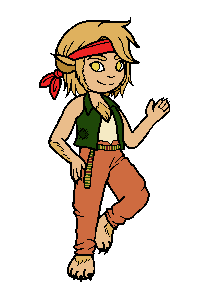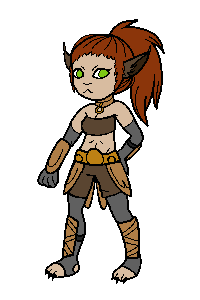| BEASTKIN |
  |
| THE FACE OF THE WILD |
| The compact frames of bestkin are wiry and muscular but vary widely otherwise depending on their specific heritage. Soft fur covers cheeks, forearms, lower legs, and trails down backs. Their eyes are dominated by large pupils, and heterochromia is more common than in other mortals. When a beastkin embraces their heritage and shifts, these animalistic features surge to the forefront. Fur coarsens and bristles, pupils pin, slit or swell, already strong nails and prominent canines harden and lengthen, posture stoops and muscles swell. Beastkin skin tones range in hue much like humans, while their hair and fur can show patterns not found in other races. |
| CYCLICAL LIVING |
| When a beastkin looks at their home, be it jungle, desert, or frozen tundra, it is a rare specimen that envisions changing that home to suit them. Instead, most respect the natural world as vast and obeying only its own cycles and ways. It is incumbent on them to fit in, not for the world to follow their whim. This is not to say that they take everything in stride: unnatural disruptions to their home can face swift and possibly violent reactions. Individual beastkin show this same duality. They are calm and accepting of larger circumstances, but are roused to frenetic and determined action when a clear adversary presents itself. Above all, however, they know that even civilization has its cycles. Nations rise and fall like seasons, and only the world itself shall remain. |
| THE STRENGTH OF THE PACK |
| In the wild, even if near or in the shadow of
other settlements, beastkin live in tribes based on familial
kinship. Within a tribe, certain heritages may predominate but
exclusivity is almost unheard-of. Because of beastkin
understanding of their environment, tribes split and migrate as
they outgrow their homelands. Practice of druidic traditions are
common among beastkin, with the learned in this art advising and
sometimes leading tribes in harmonious existence with the land.
The emphasis on harmony and living with the elements can be
misunderstood by some as passivity, but even the most peaceful
tribe can be roused to rabid defense in the face of persistent
threats. Social structures among those living in civilized
communities may approximate tribal bands, but exist in parallel to
the overarching society they share with other mortals. Most
“native” beastkin traditions have been obliterated by millenia of
iaret subjugation with only vestiges remaining in civilized
populations. |
| LONE WOLVES |
| The tribe might form the basis of natural
beastkin society, but they have been profoundly disrupted by their
past enslavement. Beastkin can be found, even if only in small
groups, wherever the iaret settled. It is not uncommon for
settlements to have an underclass population of beastkin,
surviving on the margins of society. With their innate abilities,
they are natural poachers, thieves, and scouts and many come by
adventuring via nefarious routes. Others are sent forth from
their tribe to seek answers, right a wrong, or find a new
homeland. It can be hard to fully return to the tribe once they’ve
adapted themselves to new and strange ways of life in the
civilized world. |
| BEASTKIN NAMES |
| When living among other mortals, beastkin often
have given names that help them fit in with their neighbors.
Family names tend to reflect their most beastlike heritage.
Beastkin addressing each other might habitually use both names in
all but the most hurried or informal conversations. Example Family Names: Foxcunning, Slickback, Veldtrunner, Steelskin, Longtrack |
| BEASTKIN TRAITS |
| Ability Score Increase. Your
Dexterity score increases by 1. Age. Beastkin are quick to mature both physically and emotionally, reaching young adulthood at age 10. They rarely live more than 70 years old. Alignment. Beastkin are focused on survival and tend toward neutrality. A love of personal freedom and hatred of slavery can drive beastkin toward chaotic alignments. Size. Beastkin are between 4 and a half and 5 and half feet in height. Your size is medium. Speed. Your base walking speed is 30 feet. Darkvision. You can see in dim light within 60 feet of you as if it were bright light, and in darkness as if it were dim light. You can’t discern color in darkness, only shades of grey. The Old Blood. You are immune to lycanthropy. Shifting. As a bonus action, you can assume a more bestial appearance. This transformation lasts 1 minute, until you die, or until you revert to your normal appearance. When you shift you gain temporary hit points equal to your level + your Constitution modifier (min of 1) You also gain additional benefits that depend on your subrace. Once you shift, you can’t do so again until you finish a short or long rest. Languages. You can speak, read, and write Common. Subraces. Four subraces of beastkin exist: Beasthide, Longtooth, Swiftstride, and Wildhunt. Beasthide The hallmarks of the beasthide heritage are the toughness of stone and the stubbornness of old roots. Your skin might be darker, or have a greyish tone, deepening when your heritage comes to the forefront. You are an anchor, unwilling to budge in the face of a threat. Ability score increase. Your Constitution score increases by 2. Tough. You have proficiency in the Athletics skill. Shifting feature. Whenever you shift, you can 1d6 additional temporary hit points. While shifted you have a +1 bonus to your armor class. Longtooth Longtooth beastkin are truculent and embody the savageness of nature. You’re ready to fight, and don’t mind letting anyone know it. When problems rear their head, you’re the first to try to sink your teeth into them, and hold nothing back when you go for the throat. Ability score increase. Your Strength score increases by 2. Fierce. You have proficiency in the Intimidation skill. Shifting feature. While shifted you can use your elongated fangs to make an unarmed strike as a bonus action. If you hit with your fangs, you can deal piercing damage equal to 1d6 + your strength modifier, instead of the bludgeoning damage normal for an unarmed strike. Swiftstride The world moves in cycles, but that doesn’t mean you have to wait for them. Swiftstride beastkin are on the move, apt to be nomadic in the wild and restless in cities. You’re an explorer, a curious one, greeting strangers, going places and delving into things. Ability score increase. Your Dexterity score increases by 1 and your Charisma by 1. Graceful. You have proficiency in the Acrobatics skill. Swift Stride. Your walking speed increases by 5 feet. Shifting feature. While shifted your walking speed increases by an additional 5 feet. Additionally, you can move up to 10 feet as a reaction when a creature ends its turn within 5 feet of you. This reactive movement doesn’t provoke opportunity attacks. Wildhunt Careful watchers and long thinkers are found among those with wildhunt heritage. Above other beastkin, you are most in tune with the world around you. You know where things are found and what others are doing. Some might even look to you for understanding and leadership. Ability score increase. Your Wisdom score increases by 2 and your Dexterity by 1. Natural Tracker. You have proficiency in the Survival skill. Shifting feature. While shifted you have advantage on Wisdom checks, and no creature within 30 feet of you can make an attack roll with advantage against you, unless you’re incapacitated. |
| BEASTKIN ADDENDA |
| The Eye of the Moon The idea of cycles is important to beastkin culture and understanding of the world. The waxing and waning of the moon with the seasons is one of the most apparent in nature. Beastkin who adhere to native traditions revere the moon, and might order their lives according to its phases, finding certain days better for courting, settling grudges, trading, or any other activity. This reverence leads some to the worship of Ash. The god of seasons and cycles is largely ignored by the iaret and some believe that he has a special love of the oppressed and marginalized beastkin because of this. Gods and Monsters What few truly untouched beastkin populations discovered in the modern era seem to lack the sort of organized religious beliefs of the civilized world. Instead they practice primitive animism, a vague personification of the natural world as a conscious entity to be placated and propitiated. Religious scholars hold that this is an unconscious understanding of Geb, awaiting education and enlightenment much like the ozrut worship of Mother Mountain. Darker worship of powerful magical beasts exists among native beastkin as well. Particularly among the Islands, sacrifices might be made to overwhelming threats such as dragons, giant wurms, or even ancient, mysterious constructs in order to ensure a tribe’s survival and safety. Snakes and Beasts Discussion of the beastkin is impossible without understanding their subjugation by the iaret. Aggressive nation-builders, the iaret’s domination over the scattered beastkin tribes was probably inevitable, if not divinely ordained. During the early Suzerainty, free beastkin were rare, and even an emancipated individual usually had an iaret patron that protected them. Expansion beyond the Sea of Riches began to break down this social order and by the time that the practice of slavery was outlawed following the Retreat most beastkin were already free. Even so, discrimination and patronizing attitudes towards the beastkin still exist in iaret society. For their part, most beastkin have little animosity toward their former oppressors. A cycle has turned, and the iaret sink into senescent weakness, often still cared for by beastkin servants. Who knows what the next turn might bring? Form and Function While beastkin exhibit certain animal traits in their appearance, these traits always seem to somehow match their specific heritage. A swiftstride might be lean and wiry with a leopard-spotted mane. A wildhunt’s eyes might be pinned in the manner of a wolfish stare. These resemblances, however, confine themselves to paralleling mammalian creatures. It is not known why, but it is possible that just as the iaret were given dominion by Geb, the apkallu are the messengers of Apsu, and the ptak received many gifts from Ranute, the beastkin are watched over by Ash. Kinship and Heritage Different heritages generally run in families, but beastkin can interbreed freely. This mingling means that heritages crop up in strange places, like a tribe of majority longteeth suddenly experiencing a spate of wildhunt children without a known ancestor possessing that heritage for generations. Some believe that this is nature’s way of providing the right abilities at the right time. Others point to complex theories on genetics and breeding now in vogue among natural philosophers. The New Blood and the Old Blood With widespread outbreaks of lycanthropy during the Gate War, it was inevitable that questions would be asked about what relation, if any, there was between Ash’s Curse and Ash’s beloved people. Beastkin are immune to transmitted lycanthropy but it is not understood why. Some believe that their shifting ability is an inoculation against the beastial transformation. A variant of this theory, based on the belief that lycanthropy was developed as a way to eliminate negative qualities from civilized mortals, holds that beastkin are already as innocent as wild animals. Esoteric historians, however, point to pre-civilized mythology about “people who were animals” terrorizing the iaret before the dawn of history. Could it be that the beastkin are a degenerated form of prehistoric lycanthropes, perhaps even having such savagery bred out of them by their conquerors? Whatever the truth, beastkin of martial talents are favored for attempts to quash violent outbreaks of the affliction, both in hunting lycanthropes and in bringing them down. |